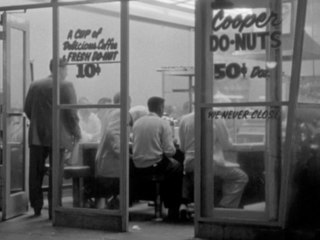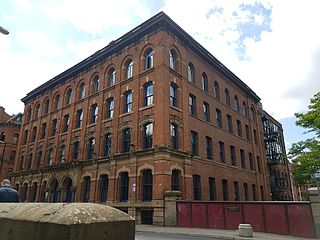
A gay village, also known as a gayborhood, is a geographical area with generally recognized boundaries that is inhabited or frequented by many lesbian, gay, bisexual, transgender, and queer (LGBT) people. Gay villages often contain a number of gay-oriented establishments, such as gay bars and pubs, nightclubs, bathhouses, restaurants, boutiques, and bookstores.

Peter Gary Tatchell is an Australian-born British human rights campaigner, best known for his work with LGBTQI+ social movements.

Church and Wellesley is an LGBT-oriented enclave in Toronto, Ontario, Canada. It is roughly bounded by Gerrard Street to the south, Yonge Street to the west, Charles Street to the north, and Jarvis Street to the east, with the core commercial strip located along Church Street from Wellesley south to Alexander. Though some LGBT-oriented establishments can be found outside this area, the general boundaries of this village have been defined by the Gay Toronto Tourism Guild.

Manchester City Centre is the central business district of Manchester, England, within the confines of Great Ancoats Street, A6042 Trinity Way, and A57(M) Mancunian Way, which collectively form an inner ring road. The City Centre ward had a population of 17,861 at the 2011 census.

Sackville Gardens is a public space in Manchester, England. It is bounded by Manchester College's Shena Simon Campus on one side and Whitworth Street, Sackville Street, the Rochdale Canal and Canal Street on the others.

The Alan Turing Memorial, situated in Sackville Gardens in Manchester, England, is a sculpture in memory of Alan Turing, a pioneer of modern computing.
Sir Cyril James Anderton was a British police officer who served as chief constable of Greater Manchester from 1976 to 1991.

Manchester Pride is a charity that campaigns for LGBTQ+ equality across the United Kingdom, predominantly in Greater Manchester. The Charity offers dialogue, training, research and policy analysis, advocacy and outreach activities focusing on LGBTQ+ rights.

The Pride Quarter, also known as the Stanley Street Quarter, Liverpool Gay Quarter or Village, is an area within Liverpool City Centre, England. It serves as the main focal point for Liverpool's lesbian, gay, bisexual and transgender community. The quarter is made up of mixed use developments including residential blocks, hotels, bars, nightclubs and various other businesses, many of which cater for the LGBT community. Aspects of the annual Liverpool Pride are also held in and around Stanley Street.

New Islington is an inner city area of Manchester, in North West England. Historically in Lancashire and part of Ancoats, it has taken a separate identity to reflect its changed status as a regeneration area.

The Birmingham Gay Village is an LGBT district next to the Chinese Quarter in Birmingham city centre, centred along Hurst Street, which hosts many LGBT-friendly businesses. The village is visited by thousands of people every week and has a thriving night life featuring clubs, sports bars, cocktail bars, cabaret bars and shops, with most featuring live entertainment including music, dancing and drag queens.

The LGBT community in Liverpool, England is one of the largest in the United Kingdom and has a recorded history since the 18th century. Many historic LGBT firsts and pioneering moments in the LGBT rights movement either took place in Liverpool or were achieved by citizens of the city.

New York City has been described as the gay capital of the world and the central node of the LGBTQ+ sociopolitical ecosystem, and is home to one of the world's largest LGBTQ populations and the most prominent. Brian Silverman, the author of Frommer's New York City from $90 a Day, wrote the city has "one of the world's largest, loudest, and most powerful LGBT communities", and "Gay and lesbian culture is as much a part of New York's basic identity as yellow cabs, high-rise buildings, and Broadway theatre". LGBT travel guide Queer in the World states, "The fabulosity of Gay New York is unrivaled on Earth, and queer culture seeps into every corner of its five boroughs". LGBT advocate and entertainer Madonna stated metaphorically, "Anyways, not only is New York City the best place in the world because of the queer people here. Let me tell you something, if you can make it here, then you must be queer."

LGBT Foundation is a national charity based in Manchester with a wide portfolio of services. With a history dating back to 1975, it campaigns for a fair and equal society where all lesbian, gay, bisexual and trans (LGBT) people are able to reach their full potential. They support over 40,000 people directly every year, and a further 600,000 online. They provide direct services and resources to more LGBT people than any other charity of its kind in the UK.

The Cooper Do-nuts Riot was an alleged uprising in reaction to police harassment of LGBT people at a 24-hour donut cafe in Los Angeles in the 1960s. Whether the riot actually happened, the date, location and whether or not the cafe was a branch of the Cooper chain are all disputed, and there is a lack of contemporary documentary evidence, with the Los Angeles Police Department (LAPD) stating that any records of such event would have been purged years ago.

42–44 Sackville Street, known originally as Sackville House with originally two separate entrances, 42 and 44 Sackville Street, is a four-storey over basement Grade II listed building in Manchester, England. It is situated in the City Centre ward, and is delimited by Sackville Street to the East, the Rochdale Canal and Canal Street to the North, and Brazil Street to the South. It is adjoined on the West side by Amazon House, and faces Sackville Gardens.
LGBT culture in Leeds, England, involves an active community of people who identify as lesbian, gay, bisexual, or transgender/transsexual. A BBC News Online article published in 2012 stated that, while Leeds City Council has not published statistics relating to the number of LGBT residents, the figure can be estimated at 10% of the overall population, which currently suggests a total of at least 77,000. The tenth year of the Leeds Pride march and celebration, held in 2016, was attended by over 40,000 people.
This is a timeline of notable events in the history of the lesbian, gay, bisexual and trans community in Manchester.

A statue of Alexander Wood was erected in Toronto, Ontario, Canada, by the Church Wellesley Village Business Improvement Area (CWVBIA) and the municipal government of Toronto on May 28, 2005. Designed and constructed by artist Del Newbigging, the 244-centimetre-tall (8 ft) bronze sculpture was installed at the corner of Church and Alexander Streets in Church and Wellesley, the gay village of Toronto. It was the first LGBT monument in Canada. The statue was removed and destroyed by the CWVBIA on April 4, 2022, amid renewed focus on Wood's ties to a group that raised funds for a mission school that later became the Shingwauk Indian Residential School.
The United Kingdom has a number of gay villages. Bigger cities and metropolitan areas are most popular as they are deemed to be more tolerant and tend to have "a history of progressive local government policy towards supporting and financing LGBTQ-friendly initiatives." There is also a noted circular pattern of migration, whereby once areas have established a reputation as somewhere LGBT people live, more LGBT people are drawn there. LGBT-inclusive areas of UK towns and cities tend to be defined by "a distinct geographic focal point, a unique culture, a cluster of commercial spaces" and sometimes a concentration of residences. It is thought that LGBT-inclusive areas help towns and cities in the UK to prosper economically, but some believe the building of such areas creates an isolating effect on some LGBT people who want to blend in.
























